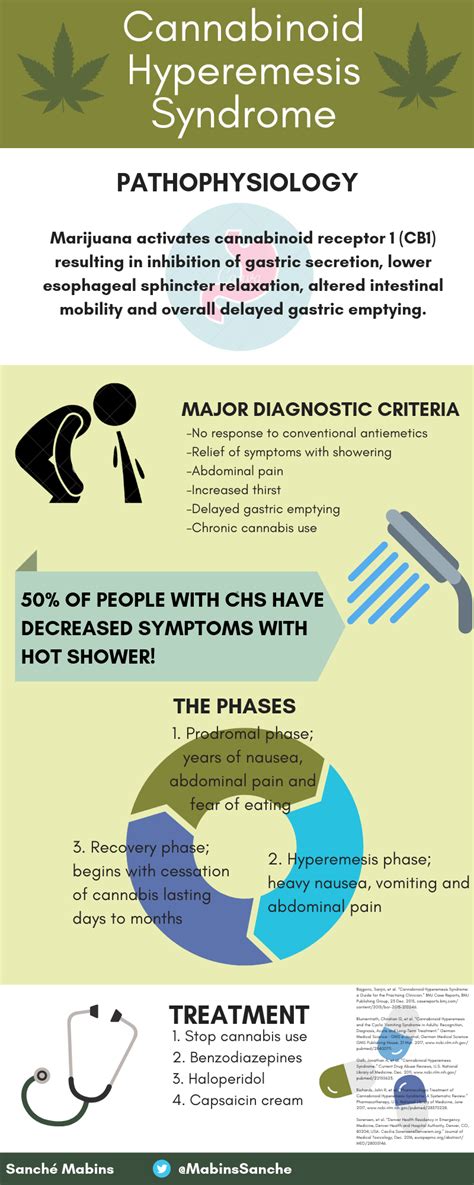Cannabinoid Hyperemesis Syndrome (CHS) is a condition that has gained significant attention in recent years due to the increasing use of cannabis products. It is characterized by recurring episodes of severe vomiting, often accompanied by abdominal pain, and is typically seen in individuals who have used cannabis regularly for an extended period. The condition is complex and not fully understood, making diagnosis and treatment challenging. In this comprehensive overview, we will delve into the latest research and expert insights to provide an in-depth understanding of CHS, its symptoms, causes, diagnosis, and treatment options.
Understanding CHS: A Historical Perspective The first reported cases of CHS date back to 2004 in Australia, where a team of researchers identified a pattern of cyclic vomiting in a group of patients who used cannabis heavily. Since then, numerous studies have been conducted to understand the mechanisms behind CHS, and it is now recognized as a distinct clinical entity. The condition is also known as cannabis hyperemesis syndrome or cannabinoid hyperemesis syndrome.
Symptoms of CHS The symptoms of CHS can be divided into three phases: prodromal, hyperemetic, and recovery.
- Prodromal Phase: This phase is characterized by abdominal pain, nausea, and a feeling of impending doom. Patients may also experience anxiety, sweating, and increased heart rate.
- Hyperemetic Phase: During this phase, patients experience severe and persistent vomiting, often accompanied by abdominal pain and weight loss. The vomiting episodes can be extremely distressing and may lead to dehydration and electrolyte imbalances.
- Recovery Phase: After the vomiting episode subsides, patients may enter a recovery phase, where they may experience a period of relative calm before the cycle repeats itself.
Causes and Risk Factors The exact causes of CHS are still not fully understood, but research suggests that it is related to the long-term use of cannabis, particularly high-potency products. The main risk factors include:
- Heavy cannabis use: Individuals who use cannabis regularly and in large quantities are at a higher risk of developing CHS.
- Prolonged use: The longer an individual uses cannabis, the higher the risk of developing CHS.
- Genetic predisposition: Some individuals may be more susceptible to CHS due to genetic factors.
Diagnosis of CHS Diagnosing CHS can be challenging, as the symptoms are similar to those of other conditions, such as cyclic vomiting syndrome or gastroesophageal reflux disease. A comprehensive medical history, physical examination, and laboratory tests are essential to rule out other potential causes of symptoms. The following criteria are used to diagnose CHS:
- Recurring episodes of severe vomiting: Patients must experience repeated episodes of severe vomiting, often accompanied by abdominal pain.
- Cannabis use: Patients must have a history of regular cannabis use.
- Exclusion of other causes: Other potential causes of symptoms must be ruled out through laboratory tests and medical evaluation.
Treatment Options for CHS Treatment for CHS typically involves a combination of lifestyle modifications, medication, and, in some cases, addiction treatment. The following strategies may be effective:
- Cessation of cannabis use: The most effective treatment for CHS is to stop using cannabis altogether.
- Medications: Medications such as anti-emetics, antacids, and pain relievers may be prescribed to manage symptoms.
- Lifestyle modifications: Patients may need to make lifestyle changes, such as avoiding triggers, practicing stress-reducing techniques, and following a healthy diet.
- Addiction treatment: In some cases, patients may require addiction treatment to address underlying cannabis use disorder.
FAQ Section
What is the primary cause of Cannabinoid Hyperemesis Syndrome?
+The primary cause of CHS is the long-term use of cannabis, particularly high-potency products.
How is CHS diagnosed?
+Diagnosing CHS involves a comprehensive medical history, physical examination, and laboratory tests to rule out other potential causes of symptoms.
What is the most effective treatment for CHS?
+The most effective treatment for CHS is to stop using cannabis altogether, combined with lifestyle modifications and medication to manage symptoms.
Can CHS be prevented?
+While CHS cannot be entirely prevented, individuals can reduce their risk by using cannabis in moderation, avoiding high-potency products, and being aware of the potential risks associated with cannabis use.
Is CHS a recognized medical condition?
+Yes, CHS is a recognized medical condition, and it is listed in the International Classification of Diseases (ICD-11) and the Diagnostic and Statistical Manual of Mental Disorders (DSM-5).
Conclusion Cannabinoid Hyperemesis Syndrome is a complex and multifaceted condition that requires a comprehensive approach to diagnosis and treatment. By understanding the causes, symptoms, and treatment options for CHS, individuals can take steps to reduce their risk and manage their symptoms effectively. As the use of cannabis products continues to evolve, it is essential to prioritize education, research, and awareness to address the potential risks associated with cannabis use.


